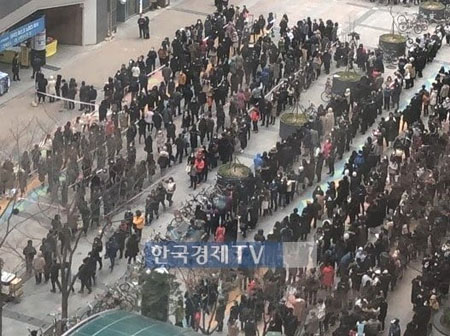by WorldTribune Staff, March 25, 2020
In January, South Korea reportedly sent millions of masks to China amid the Wuhan coronavirus outbreak.
Shortly after the Chinese government quarantined the entire city of Wuhan on Jan. 23, South Korea quickly provided China over 6 million masks, in addition to at least 42,000 protective suits, other supplies, and millions of dollars in cash, Tara O noted in a March 23 report for East Asia Research Center.

Meanwhile, “numerous articles in the West are praising the South Korean government and its handling of the Wuhan Virus, but the praise really goes to the dedicated professionals in the healthcare field. The doctors and nurses have worked hard, putting their lives and livelihood at risk, and achieved what they have achieved, not due to, but in spite of the Moon administration,” the report said.
“The Moon administration has repeatedly ignored the advice and pleas from the doctors and nurses. Not banning entry from China is a huge problem.”
The South Korean government delivered 3 million masks, 10,000 protective suits, and medical supplies and cash worth $5 million to China “on the same chartered aircraft that was contracted to bring back South Korean citizens from Wuhan,” according to the report. Now, “there are not enough masks and protective suits for the health care workers treating the Wuhan Virus-infected patients at hospitals in South Korea.”
The South’s shortage of masks “contrasts with the action of the government of Taiwan. Taiwan’s government banned mask exports early on Jan. 24, stating it needs to look out for its own people first,” Tara O noted. “It also started to restrict passengers from Wuhan on Dec. 31, a month before the South Korean government did so, which was after the Chinese government already quarantined Wuhan. Taiwan suspended all tours to China on Jan. 25, and banned all visitors from China on Feb. 6. The South Korean government never banned entry from China (other than Wuhan), despite numerous calls for it from Korean Medical Association and its citizens.”
The Moon administration’s “refusal to ban entry from China led to rapid spread of the coronavirus in South Korea, leading to 157 countries restricting or banning travelers from South Korea, as of March 18,” the report said. “Ironically, China also restricted travel from South Korea.”
In East Asian countries, it has long been normal to see people with only a mild cold wearing face masks on the street or in stores.
“South Korean citizens searched around for masks for hours, only to go home empty handed. Now, a person can only purchase 2 masks a week with an identification card, if they can find masks to buy after standing in long lines. Many in South Korea are blaming the South’s sending so many masks to China as a primary reason for mask shortages.”
South Koreans “are certainly getting a taste of socialism/communism” and “are also put at greater risk of contracting coronavirus by having to stand in crowded lines,” Tara O wrote.
The Moon administration “added a layer to the distribution of masks, selecting 2 contractors that are making millions of dollars in a short amount of time,” the report stated. “The main contractor Geo-Young seems to have Chinese funding. Some in Korea suspect the profit from mask sales are going toward candidates who the Chinese Communist Party favors in the South’s upcoming elections.
South Korean National Assemblyman Ji Sang-Wuk said at the National Assembly’s Political Committee Meeting on March 5 that “Over 1 million (masks) are handed over everyday to Xiaomi [Chinese electronics company based in Beijing], disguised as Red Cross relief products, even after the government’s export restrictions.”
On average, 10,000 to 30,000 Chinese tourists visit South Korea daily. On Jan. 31, while the Wuhan virus was rapidly spreading across China, 11,345 visitors from China entered South Korea. Using that as an average, 340,350 visitors would enter South Korea in a 30-day month. “If 1 percent of the visitors from China were infected with the coronavirus, that would be 3,403 people, at 5 percent, it would be 17,018 and at 10 percent, it would be 34,035 in one month,” Taro O noted.
Intelligence Brief __________ Replace The Media
